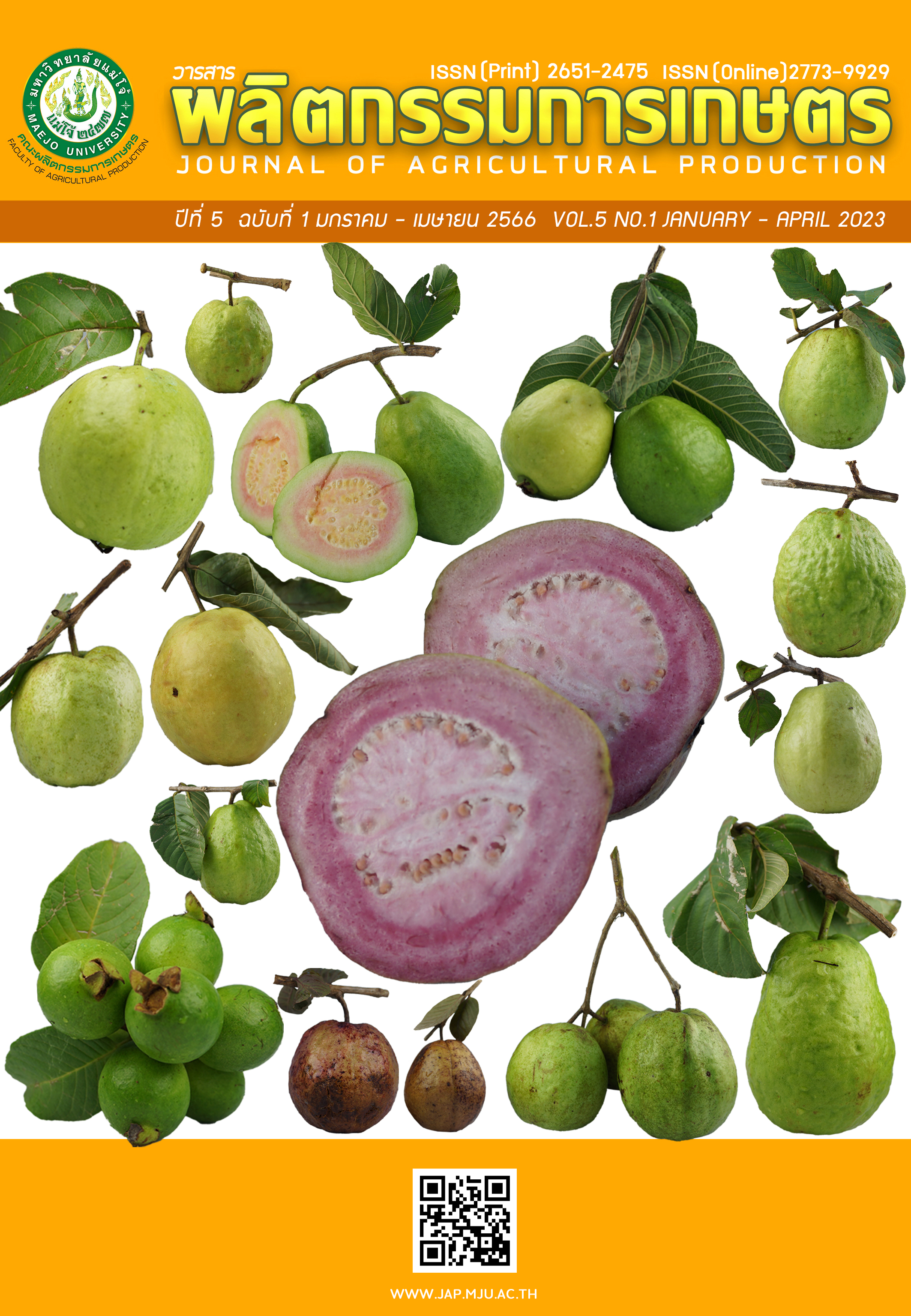ผลของรังสีแกมมาต่อการเจริญเติบโต ลักษณะทางสัณฐานวิทยา และปริมาณสารเคอร์คิวมินของขมิ้นชัน
Main Article Content
บทคัดย่อ
ศึกษาผลของรังสีแกมมาต่อเปอร์เซ็นต์การงอกและการรอดชีวิตของขมิ้นชัน หลังจากได้รับรังสี เป็นเวลา 8 สัปดาห์ โดยนำเหง้าขมิ้นชันไปฉายรังสีแบบเฉียบพลันด้วยเครื่องฉายรังสีแกมมาที่มีโคบอลต์-60 เป็นต้นกำเนิดรังสี ที่ระดับ 0 ถึง 200 เกรย์ ณ สาขาวิชาฟิสิกส์ประยุกต์ คณะวิทยาศาสตร์ มหาวิทยาลัยแม่โจ้ จังหวัดเชียงใหม่ พบว่าระดับรังสีแกมมาที่ทำให้เหง้าขมิ้นชันมีอัตราการงอกและการรอดชีวิต 50 เปอร์เซ็นต์ (Lethal Dose 50; LD50) เท่ากับ 50.24 เกรย์ จากนั้นศึกษาผลของรังสีแกมมาต่อการเจริญเติบโต ลักษณะทางสัณฐานวิทยา และปริมาณสารเคอร์คิวมินของขมิ้นชันที่ได้รับรังสีแกมมาแตกต่างกัน 11 ระดับ (0, 5, 10, 15, 20, 25, 30, 35, 40, 45 และ 50 เกรย์) โดยปลูกทดสอบ ณ สำนักฟาร์มมหาวิทยาลัยแม่โจ้ จังหวัดเชียงใหม่ ระหว่างปี พ.ศ. 2561 ถึงปี พ.ศ. 2562 พบว่า การได้รับรังสีแกมมาตั้งแต่ระดับ 10 เกรย์ ส่งผลให้ความสูงของลำต้นเทียมและจำนวนหน่อของลดลง รังสีตั้งแต่ระดับ 35 เกรย์ ทำให้ความยาวใบลดลง แต่รังสีแกมมาทุกระดับของการทดลองไม่มีผลต่อความกว้างของใบ ในขณะที่รังสีแกมมาระดับ 0, 20 และ 30 เกรย์ ส่งผลให้ขมิ้นชันมีจำนวนใบสูงที่สุด และเมื่อเก็บเกี่ยวขมิ้นชันหลังได้รับรังสี 32 สัปดาห์ การได้รับรังสีแกมมาตั้งแต่ระดับ 40 เกรย์ ส่งผลให้ผลผลิตเหง้าสดของขมิ้นชันลดลง ส่วนนํ้าหนักเหง้าแห้งลดลงตํ่าที่สุดเมื่อได้รับรังสีระดับ 50 เกรย์ และปริมาณสารเคอร์คิวมินลดลงเมื่อได้รับรังสีแกมมาตั้งแต่ 30 เกรย์ นอกจากนี้ยังพบการเปลี่ยนแปลงลักษณะทางสัณฐานวิทยาของขมิ้นชันที่ได้รับรังสีแกมมา ได้แก่ ลำต้นเทียมแคระแกร็น กาบใบและลำต้นเทียม มีลักษณะผิดปกติ ขอบใบม้วนงอ ผิวใบย่นไม่เรียบ ลักษณะใบด่าง เหง้ามีขนาดเล็ก และพบรากสะสมอาหารขนาดใหญ่
Article Details

อนุญาตภายใต้เงื่อนไข Creative Commons Attribution-NonCommercial-NoDerivatives 4.0 International License.
เอกสารอ้างอิง
กระทรวงสาธารณสุข. 2555. บัญชียาหลักแห่งชาติ. สำนักยา, กลุม่ งานพัฒนาระบบ, งานระบบยาแห่งชาติและสารสนเทศ, กระทรวงสาธารณสุข, นนทบุรี. 98 หน้า.
Abdullah, S., N.Y. Kamaruddin and A.R. Harun. 2018. The effect of gamma radiation on plant morphological characteristics of Zingiber officinale Roscoe. Int. J. Adv. Sci. Eng. Inf. Technol. 8(5): 2085-2091.
Ayer, D.K. 2017. Breeding for quality improvement in turmeric (Curcuma longa L.): a review. Adv. Plants Agric. Res. 6(6): 201-204.
Bhadra, S. and M. Bandyopadhyay. 2015. Karyomorphological investigations on some economically important members of Zingiberaceae from Eastern India. Caryologia 68(3): 184-192.
Billore, V., S.J. Mirajkar, P. Suprasanna and M. Jain. 2019. Gamma irradiation induced effects on in vitro shoot cultures and influence of monochromatic light regimes on irradiated shoot cultures of Dendrobium sonia orchid. Biotechnol. Rep. 24: e00343.
Bonna, I.J., S. Akter and S.S. Sultana. 2021. Somatic chromosome number and ploidy level in three Curcuma spp. from Bangladesh. Dhaka Univ. J. Biol. Sci. 30(2): 133-140.
Chusreeaeom, K. and O. Khamsuk. 2019. Effects of gamma irradiation on lipid peroxidation, survival and growth of turmeric in vitro culture. J. Phys. Conf. Ser. 1285.
Devi, H.U.N., and N. Chezhiyan. 2006. Impact of gamma rays on turmeric crop (Curcuma longa L.). J. Hortic. Sci. 1(2): 124-128.
Due, M.S., A. Susilowati, A. Yunus. 2019. The effect of gamma rays irradiation on diversity of Musa paradisiaca var. Sapientum as revealed by ISSR molecular marker. Biodiversitas 20: 1416-1422.
Hapsari, L., T. Trimanto, Y. Isnaini and S. Widiarsih. 2021. Morphological characterization and gamma irradiation effect on plant growth of Curcuma heyneana Val & Zijp. AIP Conference Proceedings 2353, 030012 (2021); New York. pp. 1-10.
Ilyas S. and S. Naz. 2014. Effect of gamma irradiation on morphological characteristics and isolation of curcuminoids and oleoresins of Curcuma longa L. J. Anim. Plant Sci. 24(5): 1396-1404.
Kapare, V., R. Satdive, D.P. Fulzele and N. Malpathak. 2017. Impact of gamma irradiation induced variation in cell growth and phytoecdysteroid production in Sesuvium portulacastrum. J. Plant Growth Regul. 36(4): 919-930.
Katiyar, P., N. Pandey and S. Keshavkant. 2022. Gamma radiation: A potential tool for abiotic stress mitigation and management of agroecosystem. Plant Stress 5: 100089.
Li, S., W. Yuan, G. Deng, P. Wang, P. Yang and B. Aggarwal. 2011. Chemical composition and product quality control of turmeric (Curcuma longa L.). Pharm. Crop. 2: 28-54.
Ma, X. and D.R. Gang. 2006. Metabolic profiling of turmeric (Curcuma longa L.) plants derived from in vitro micropropagation and conventional greenhouse cultivation. J. Agric. Food Chem. 54: 9573-9583.
Ma’Arup, R., N.S. Ali, F. Ahmad, Z. Ahmad, M.F.M. Norawi and H.F. Moinuddin. 2022. Effects of gamma irradiation on morphology and protein differential in M1V1 population of Vanilla planifolia Andrews. Int. J. Radiat. Biol. doi: 10.1080/09553002.2022.2087932.
Majeed, A., Z. Muhammad, R. Ullah, Z. Ullah, R. Ullah, Z. Chaudhry and S. Siyar. 2017. Effect of gamma irradiation on growth and post-harvest storage of vegetables. PSM Biol. Res. 2(1): 30-35.
Mirjanaik, R.H. and Y.C. Vishwanath. 2020. Advances in production technology of turmeric. J. Pharmacogn. Phytochem. 9(4): 1198-1203.
Nair, R., K.N. Shiva and J. Zachariah. 2010. Characterization of open-pollinated seedling progenies of turmeric (Curcuma longa L.) based on chromosome number, plant morphology, rhizome yield and rhizome quality. Cytologia 75(4): 443-449.
Nandhini, D., H. Usha and N. Chezhiyan. 2007. Influence of gamma rays induced mutagenesis on the frequency of viable mutants in turmeric. Asian J. Hort. 2(1): 54-57.
Pistellia, L., A. Bertolib, F. Gellib, L. Bedinia, B. Ruffonic and L. Pistelli. 2012. Production of curcuminoids in different in vitro organs of Curcuma longa. Nat. Prod. Commun. 7(8): 1037-1042.
Priya I.N., V. Devappa, M.S. Kulkarni and G. Prabhulinga. 2014. Effect of gamma radiation on growth of turmeric (Curcuma longa L.) cv. Salem explants. Karnataka Journal of Agricultural Sciences 27(2): 152-155.
Riviello-Flores, M. de la L., J. Cadena-Iñiguez, L. del M. Ruiz-Posadas, M. de L. Arévalo-Galarza, I. Castillo-Juárez, M.S. Hernández and C.R. Castillo-Martínez. 2022. Use of gamma radiation for the genetic improvement of underutilized plant varieties. Plants 11(9): 1161.
Roslim D.I., H. Herman and I. Fiatin. 2015. Lethal dose 50 (LD50) of mungbean (Vigna radiata L. Wilczek) cultivar Kampar. Sabrao J. Breed. Genet. 47(4): 510-516.
Sungkajorn, M., P. Treewannakul and P. Sukprasert. 2021. Possibility of turmeric production with good agricultural practice of farmers in Paphayom district, Phatthalung province. Thai J. Agric. Sci. 52(2): 107-117.
Suthon, W. 2019. Effect of shading on growth, yield and curcumin content of Zingiber montanum (Koenig) Link ex Dietr. Srinakharinwirot University Journal of Science and Technology 11(22): 146-156.
Taheri, S., T.L. Abdullah, Z. Ahmad and N.A.P. Abdullah. 2014. Effect of acute gamma irradiation on Curcuma alismatifolia varieties and detection of DNA polymorphism through SSR marker. Biomed Res. Int. 2014: 631813.


